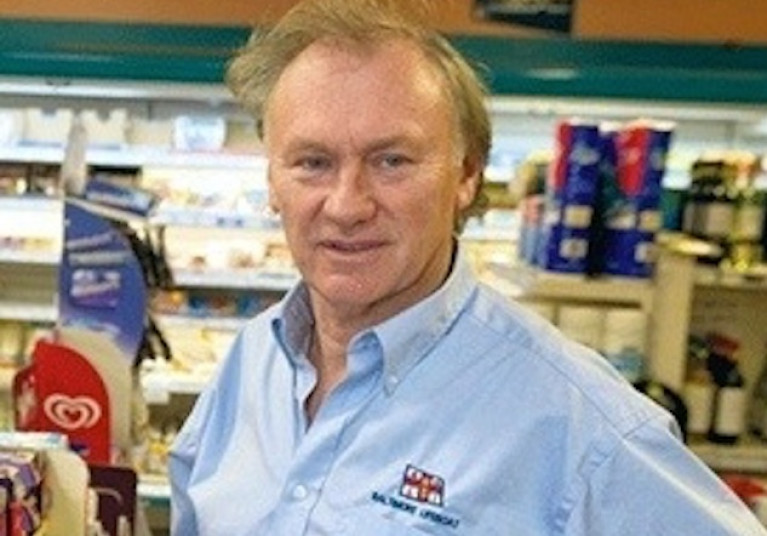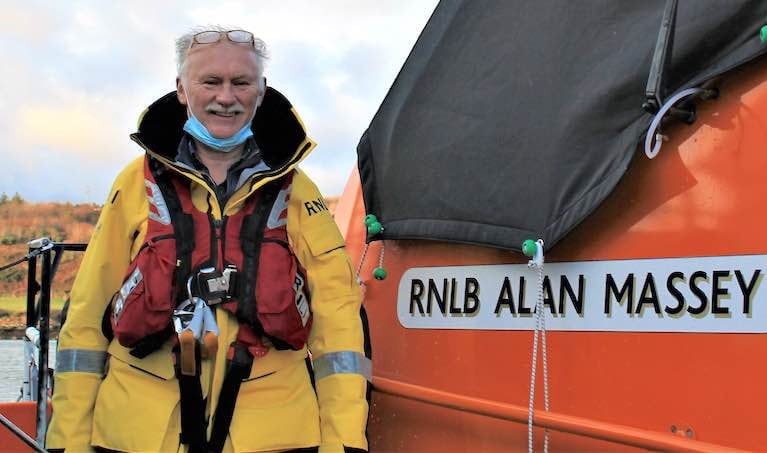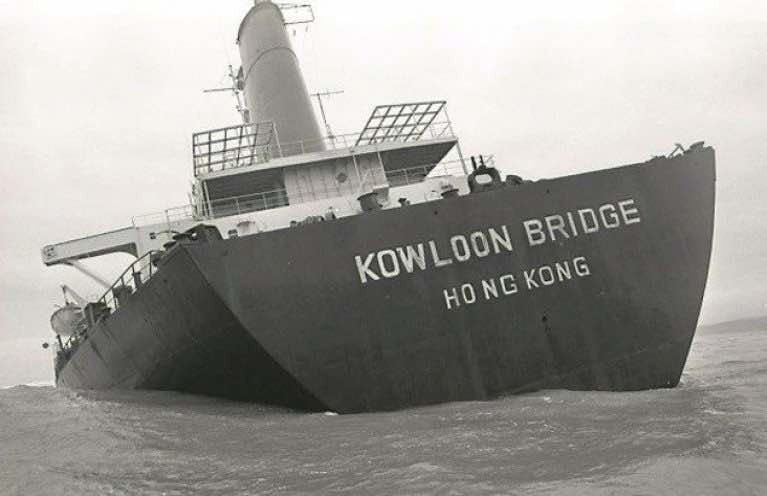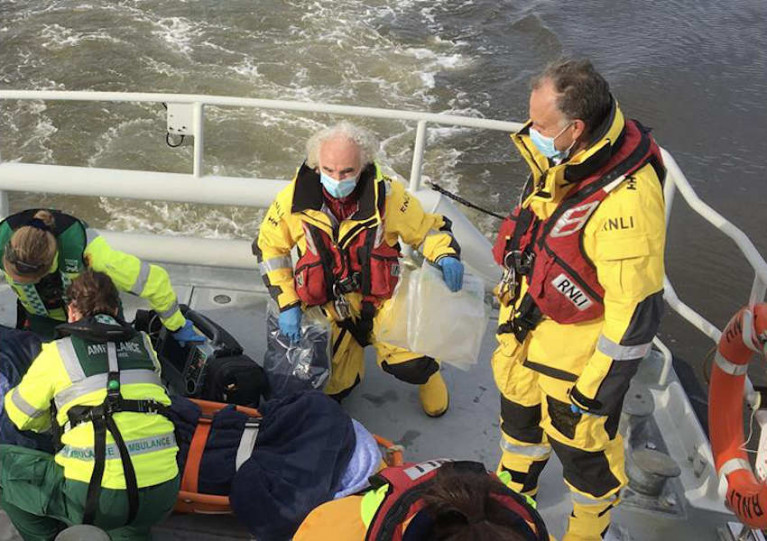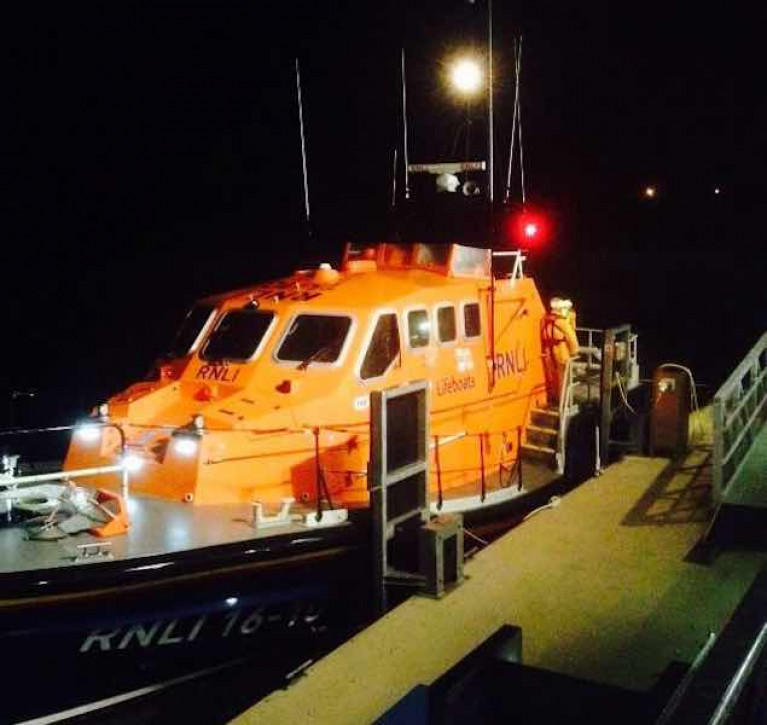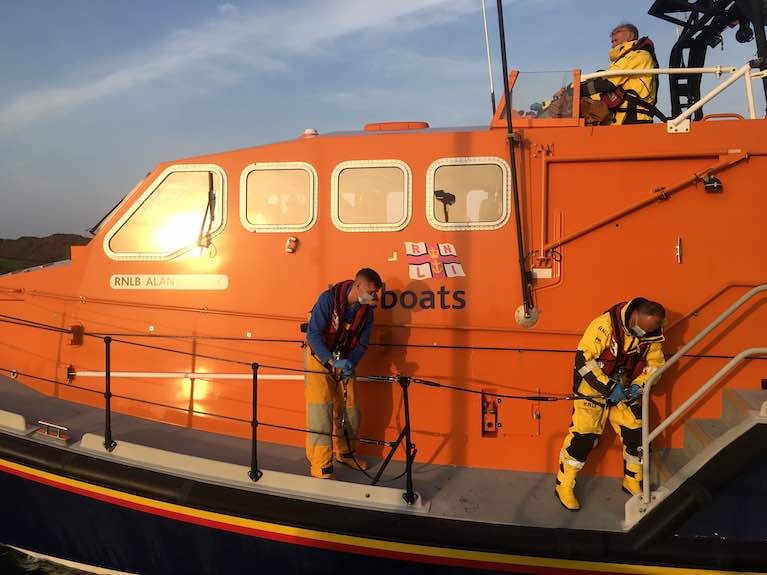Displaying items by tag: Baltimore
Baltimore RNLI was called out to provide a medical evacuation in the early hours of this morning (Monday 3 May) from Sherkin Island off the coast of Baltimore, West Cork.
The volunteer lifeboat crew launched their all-weather lifeboat at 00.28 am, following a request from the Irish Coast Guard to provide medical assistance and evacuation to a man living on the island.
The Baltimore all-weather lifeboat crew arrived at Sherkin Island pier at 00.39 am. Three voluntary lifeboat crew members proceeded to the casualty’s location where they administered casualty care and then transferred him by stretcher back to the lifeboat. The lifeboat departed Sherkin at 01.19 am and handed the casualty over to the HSE paramedics who were waiting at Baltimore lifeboat station.
There were seven volunteer crew onboard the lifeboat, Coxswain Aidan Bushe, Mechanic Cathal Cottrell and crew members Micheal Cottrell, Colin Whooley, Brian McSweeney, Jerry Smith and Don O’Donovan. Conditions in the harbour during the call out were calm with a south-westerly force 2-3 wind and no sea swell.
Speaking following the call out, Kate Callanan, Baltimore RNLI Volunteer Lifeboat Press Officer said: ‘Baltimore RNLI often provide medical evacuations to residents of islands off the coast of West Cork.
Baltimore RNLI was called out to provide assistance to a yacht in difficulty in Baltimore harbour, West Cork this afternoon (Monday 3 May) in a second callout of the day.
The volunteer lifeboat crew launched their inshore lifeboat at 12.05 pm, following a request from the Irish Coast Guard to provide assistance to a yacht with two people on board that was in difficulty in strong wind and rough seas in Baltimore harbour.
The Baltimore inshore lifeboat crew arrived at the casualty vessel at 12.09 pm and discovered it had broken free from a mooring and was caught by its rudder on a line in the harbour. Voluntary lifeboat crew member David Ryan went aboard the casualty vessel to establish a tow. The Baltimore inshore lifeboat towed the vessel through rough conditions in the harbour and put the boat on a mooring in the shelter of Sherkin Island. An anchor was also dropped from the yacht for added security. The occupants of the yacht were then brought back to Baltimore, and the lifeboat returned to station, arriving at 12.43 pm.
There were four volunteer crew onboard the lifeboat, Helm Micheal Cottrell and crew members Pat O’Driscoll, David Ryan and Ian Lynch. Also assisting at the boathouse were Jerry and Rianne Smith. Conditions in the harbour during the call were very windy with a south-westerly force 7-8 wind and 1.5m sea swell.
Speaking following the call out, Kate Callanan, Baltimore RNLI Volunteer Lifeboat Press Officer said: ‘The crew of the yacht did the right thing in alerting the Irish Coast Guard as soon as they knew they were in trouble as it could have escalated very quickly in the poor weather conditions in the harbour at the time.
This is the second call of the day for Baltimore RNLI who were called out to a Medevac on Sherkin Island in the early hours of this morning.
Kieran Cotter of Baltimore is Sailor of the Month for January
The retirement of Kieran Cotter, after 45 years of distinguished service with the Baltimore RNLI Lifeboat, puts the focus on a remarkable individual who combines a busy life afloat with solid community and commercial activity ashore in playing a key role towards the building of Baltimore's prosperity and vitality.
His lifeboat service, as revealed here is probably unrivalled in its variety, and it's no exaggeration to say that he is one of Ireland's best-known lifeboatmen.
His contribution has been augmented by his keen awareness of the lifeboat's larger role in every aspect of an enthusiastic maritime community like Baltimore, and it was during his time as cox'n that the Baltimore Lifeboat sent forth a racing crew which sailed to second place overall in the Inter-services Racing for the Beaufort Cup in Cork Week at Crosshaven.
Baltimore RNLI Coxswain Kieran Cotter Retires After 45 years of Service
Yesterday, Wednesday 30 December 2020, marked the end of an era for the Baltimore RNLI Lifeboat with the retirement of Coxswain Kieran Cotter after 45 years of service.
At age 17, Kieran first became interested in Baltimore Lifeboat and he officially joined the crew on 1st January 1975. In the early years as a crew member Kieran was involved in the dramatic rescue of the 1979 Fastnet Race. Baltimore Lifeboat was the first lifeboat launched and spent the longest time at sea during the tragedy. At the time it was the biggest rescue operation since World War 2. Kieran and his brother Liam were also involved in the rescue of Charles J. Haughey in 1985.
 Socially distanced and by a fishing rod, Kieran Cotter hands over the lifeboat keys to Baltimore RNLI’s new Coxswain Aidan Bushe Photo RNLI/Micheal Cottrell
Socially distanced and by a fishing rod, Kieran Cotter hands over the lifeboat keys to Baltimore RNLI’s new Coxswain Aidan Bushe Photo RNLI/Micheal Cottrell
Kieran held the position of second Coxswain for a number of years before becoming Coxswain following the retirement of Christy Collins in 1989. During his 45 years at the station Kieran has received multiple awards for his roles in many rescues. Most notably, in 1991 Kieran was awarded the Bronze Medal for gallantry and the Maud Smith award for the bravest act of life saving that year following the 26-hour rescue of the fishing vessel the Japonica and her 15 crew, who referred to Baltimore lifeboat and her crew as “The Mad Men in the small boat” and the rescue of the yacht Atlantis Adventure and her five crew. Coxswain Cotter and his crew also received recognition from the Swiss Embassy in 2008 for the outstanding bravery and commitment shown during the rescue of Swiss nationals in hazardous conditions and from the United States Congress for the rescue of the crew of Rambler during the 2011 Fastnet Yacht Race.
Kieran has seen many changes during his time at the station including the arrival of four different classes of all-weather lifeboats and the reconstruction of the lifeboat station and pen at Bull Point to accommodate the current Tamar Class all-weather lifeboat the Alan Massey and the Atlantic 85 inshore lifeboat the Rita Daphne Smyth. In September 2019 Kieran accepted the 100th Anniversary Vellum on behalf of the crew, management and fundraising team at Baltimore station.
 Long-serving Baltimore RNLI Coxswain Kieran Cotter and Crewmember Ronnie Carthy on their last call out in October 2020 Photo: RNLI/Micheal Cottrell
Long-serving Baltimore RNLI Coxswain Kieran Cotter and Crewmember Ronnie Carthy on their last call out in October 2020 Photo: RNLI/Micheal Cottrell
Owen Medland, RNLI’s Lifesaving Lead Ireland, paid testimony to Kieran’s service. “It is true to say that the RNLI is built upon its people and in Kieran the team in Baltimore have had firm foundations. One of the longest serving Coxswains in the country entrusted with the safety of Baltimore’s lifeboats and crews since the late 80’s having joined as crew in 1975 Kieran has a remarkable record of lifesaving service and community commitment. As with every volunteer this service would not have been possible without the support of family and we are equally grateful for this support which has enabled Kieran to serve his community so well. We wish Kieran every health and happiness in his next chapter and he leaves the RNLI in Baltimore in good hands to continue their lifesaving work on the challenging coast of west Cork. Kieran has left a legacy of lives saved from the sea and witnessed the evolution of the RNLI’s service provision in the area over 5 decades for which he should be justifiably proud - thank you Kieran Cotter.”
Declan Tiernan, Chairperson of Baltimore Lifeboat, paid tribute to Kieran saying “Natural leadership is a rare gift which Kieran Cotter has in abundance. It is the ability to instill confidence and trust in the people around you, calmly dealing with new and unforeseen circumstances without raising your voice. The ability to assess a situation, come up with a plan that your crew will execute because they have the utmost confidence in their leader.
“Kieran is also a wonderful communicator; in dangerous situations, he can put people at ease, at other times journalists will want to go to Kieran for the most accurate report.
Napoleon Bonaparte famously said that he’d rather have lucky generals than good ones. Well, Kieran Cotter is not only a good leader but also brings luck with him.
“Kieran Cotter gave forty-five years of service to the Baltimore Lifeboat and when you think that in 2019 we celebrated the centenary of the first lifeboat arriving in Baltimore it really puts Kieran’s service into perspective.”
Tom Bushe, Baltimore RNLI Lifeboat Operations Manager, added “I first worked with Kieran when I stared as crew in the 1980s. Over the years his dedication and commitment to the Baltimore RNLI has been exceptional and his advice to me in my role has been invaluable. Fortunately, Kieran’s vast array of knowledge and experience will not be lost to Baltimore RNLI as he is going to continue to be involved by becoming a Deputy Launching Authority. I must also mention Ronnie Carthy, another long serving crew member who also retires this week. Ronnie was also an outstanding crewmember of the lifeboat for almost 30 years.”
Kieran is leaving the Alan Massey and her crew in good hands, with second Coxswain Aidan Bushe now taking over the role as station Coxswain. In these times of social distancing Baltimore Lifeboat Station are sadly unable to give Kieran the send off he deserves, but we look forward to celebrating with him sometime in the future.
Baltimore Thoughts: The Beacon, The Kowloon Bridge & Richard Bushe
The Beacon at Baltimore can be a miserable place. It's nice to see on a good Summer's day sailing by and bound for the harbour entrance, but it's different in nasty weather.
That's what I had remembered this past week - the time when an enormous vessel, 900 feet long, threatened to become a huge plug blocking that entrance.
It was around 1 a.m. on a rotten late November morning in 1986, dark, cold, wet, howling gale to brace oneself against "up at the Beacon", watching the abandoned, powerless Kowloon Bridge, driven by the power of a huge gale, towards Baltimore. She had been sheltering in Bantry Bay after damage sustained in another gale while crossing the Atlantic. She wasn't a lucky ship. Anchoring failed and, in fear of hitting another very large tanker, the Capo Emma, also sheltering in the Bay and with 80,000 tonnes of crude oil aboard, the Indian officers in charge decided to put to sea – into winds reported at 70 miles an hour, seas over 40 feet high.
 The Beacon at Baltimore Harbour on the West Cork coast Photo: W M Nixon
The Beacon at Baltimore Harbour on the West Cork coast Photo: W M Nixon
With no luck at all, her steering failed, and the crew of 27 were rescued by RAF Sea King helicopters from the Royal Naval Air Station at Culdrose in Cornwall, then providing rescue cover in Irish waters.
I was one of the crowds of reporters, cameramen and local people that morning at the Beacon, watching the ghostly shape of the ship, seeming to be swinging towards the entrance to the West Cork Harbour. The local view was that, if it hit rocks there, Baltimore could be blocked for a long time!
Mercifully it didn't, the seas headed it eastwards, and she grounded on the Stags from where the Dutch salvage company, Smith Tak, couldn't shift it. In a few months, the seas on the West Cork coastline did that work. The Kowloon Bridge disappeared beneath the waves, worn away by its futile battle against the elements of Nature.
I recalled that in the past week when I heard of the death of a man whom I knew for many years and was one of those concerned about the Kowloon Bridge that morning. He was Richard Bushe, who died at the age of 91 died at his appropriately maritime-named home - The Cove Baltimore. His village pub, still run by the family, is one of the most well-known maritime locations in Ireland and to visitors from overseas, the place to which every sailor visiting Baltimore called. He was one of the strongest supporters of Baltimore Sailing Club since its inception in the early 1950s.
 Richard Bushe - a strong supporter of Baltimore Sailing Club
Richard Bushe - a strong supporter of Baltimore Sailing Club
As Charlie Bolger, Commodore of Baltimore Sailing Club wrote on the club's website: "You won't find his name amongst the list of Commodores, but Richard Bushe quietly contributed support to every Commodore with his sound advice and wisdom over the past sixty years. He was the go-to person for sailors seeking local knowledge on any topic."
Bushe's Bar has always been to me like a little maritime museum; there is so much of the lore of the sea there – maps, artefacts, items contributed by visiting and local sailors over many years. It is the go-to-place when one is in Baltimore, a place of many memories, of which Richard Bushe was certainly one.
Looking back to those days of the Kowloon Bridge, when the media centred itself at Baltimore as the story of environmental damage and pollution was reported, I also think how unprotected our waters and coastline were, how the State didn't seem to get any adequate compensation for the damage caused, there was no inquiry and Cork County Council, and its ratepayers wound up with most of the cost of €500,000. And, most of all, looking at pictures of that huge vessel, how the power of the sea at the Stags did what human endeavour couldn't do and removed that massive 900-foot vessel from sight. Today it's cargo of 160,000 tonnes of iron ore pellets, said to have been insured for stg£2.7m., still lies on the seabed.
Listen to the Podcast here.
Baltimore Lifeboat Launches for Medevac from Heir Island
Baltimore RNLI were called out to provide a medical evacuation this morning (Friday 30 October) from Heir Island off the coast of West Cork.
The volunteer crew launched their all-weather lifeboat at 9.22am following a request from the Irish Coast Guard to provide medical assistance and evacuation to a man living on the island.
Along with two HSE paramedics, the lifeboat crew arrived at Heir Island pier just 10 minutes later and used a stretcher to transfer the casualty from his home to the lifeboat, and then back to the station and the awaiting ambulance.
Conditions at sea during the callout were calm, with a westerly Force 2 wind and no sea swell, ahead of the strong winds expected with Storm Aiden tomorrow, Saturday 31 October.
There were seven volunteer crew onboard the lifeboat: coxswain Kieran Cotter, mechanic Micheal Cottrell and crew members Aidan Bushe, Brendan Cottrell, Ronnie Carthy, Emma Lupton and Jerry Smith.
Baltimore RNLI in Medical Evacuation from Sherkin Island
Baltimore RNLI was called out to provide a medical evacuation late last night (Sunday 18 October) from Sherkin Island off the coast of Baltimore, West Cork.
The volunteer lifeboat crew launched their all-weather lifeboat at 11.39 pm, following a request from the Irish Coast Guard to provide medical assistance and evacuation to a female who had sustained an injury to her arm.
The Baltimore all-weather lifeboat crew along with two HSE paramedics arrived at Sherkin Island pier at 11.47 pm. The voluntary lifeboat crew brought the casualty onboard the lifeboat. After an initial assessment was carried out by the HSE paramedics, a lifeboat crew member assisted in the administration of casualty care and the casualty was able to return home. The lifeboat then departed Sherkin at 00.07 am and arrived to the station in Baltimore at 00.18 am.
There were five volunteer crew onboard the lifeboat, Coxswain Kieran Cotter, Mechanic Micheal Cottrell and crew members Ronnie Carthy, Sean McCarthy and David Ryan, along with two paramedics from the HSE. Conditions in the harbour during the call out were calm with a south-easterly force 5 wind, which created heavy runs at Sherkin pier.
Proposed Sea Memorial for Baltimore Village
A memorial to commemorate those lost to the sea is finally in sight for a coastal village in West Cork. For the past twelve months, Baltimore Rath & the Islands Community Council has been liaising with Cork County Council and the community of Baltimore and has now successfully acquired planning permission to erect the memorial within the village.
The memorial, “Croí na Mara” (the Heart of the Sea), a sculpture of copper, bronze and stainless steel, is a collaborative work between the Community Council and two local artists, Helen Walsh and Paddy McCormack. The artist’s sketch shows that the structure made up of two waves (measuring 3m H x 2m L x 3m W) aims to reflect and capture the power and energy of the sea. Further detail shows the parting sea forming two copper and bronze perforated waves rising from the ground into the shape of a heart. Copper rings of varying sizes, representing the souls lost to the sea, are drawn up through the heartstrings and released into the air.
The structure will be located adjacent to the Harbour Building overlooking Baltimore pier and harbour. The aim is to make the memorial area as inclusive as possible for people of all abilities to come and take the opportunity to reflect, contemplate, and remember friends and loved ones by looking at and through the heart-shaped space between the waves, to the water in the harbour and beyond.
The Community Council are currently fundraising to reach a target of €35,000 to see the project completed. This has been a difficult year for everyone, but the community council would be very grateful to those who would consider donating to this community project, which is a thoughtful opportunity to appropriately commemorate those that have been lost to the sea.
Baltimore RNLI Provides Third Medical Evacuation Within 48 hours
Baltimore RNLI was called out to provide a medical evacuation early yesterday afternoon (Monday, 21 September) from Sherkin Island off the coast of Baltimore, West Cork.
The volunteer lifeboat crew launched their all-weather lifeboat at 2.07 pm, following a request from the Irish Coast Guard to provide a medical evacuation (Medivac) to an injured female.
The Baltimore all-weather lifeboat arrived at Sherkin Island at 2.20 pm. The lifeboat crew brought the casualty onboard the lifeboat and they departed the island at 2.30 pm. The lifeboat arrived back to Baltimore Lifeboat Station at 2.45 pm where the casualty was handed over to the care of the HSE ambulance crew.
There were five crew onboard the lifeboat, Coxswain Kieran Cotter, Mechanic Cathal Cottrell and crew members Sean McCarthy, Aidan Bushe and Emma Lupton.
Conditions within the harbour at the time were calm with a westerly force 4 wind and no sea swell.
Speaking following the call out, Kate Callanan, Baltimore RNLI Volunteer Lifeboat Press Officer said: ‘This is the third Medivac for Baltimore within a 48 hour period. Previously there were two Medivacs to Cape Clear Island, the first on Saturday evening and the second on Sunday morning. If you find yourself in need of medical assistance whilst on an island, call 999 or 112.’
Baltimore RNLI on Two Call Outs Within 14 hours
Baltimore RNLI was called out twice in 14 hours to provide two separate medical evacuations from Cape Clear Island off the coast of Baltimore, West Cork.
The first call out happened yesterday evening (Saturday 19 September). The volunteer lifeboat crew launched their all-weather lifeboat at 6.49 pm, following a request from the Irish Coast Guard to provide a medical evacuation (Medivac) to an islander from Cape Clear.
The Baltimore all-weather lifeboat crew arrived at Cape Clear Island at 7.10 pm. After an initial assessment, the voluntary lifeboat crew brought the casualty onboard the lifeboat and they departed the island at 7.14 pm. The lifeboat arrived back to Baltimore Lifeboat Station at 7.42 pm where the casualty was handed over to the care of the HSE ambulance crew.
There were six volunteer crew onboard the lifeboat, Coxswain Kieran Cotter, Mechanic Sean McCarthy and crew members Jerry Smith, Aidan Bushe, David Ryan and Jim Griffiths.
The second call-out came earlier this morning (Sunday 20 September) when at the request of the Irish Coast Guard the volunteer lifeboat crew launched their all-weather lifeboat at 8.24 am, to provide another Medivac to an islander from Cape Clear.
The Baltimore all-weather lifeboat crew arrived at the island at 8.47 am and transported the casualty back to Baltimore, departing Cape Clear at 8.57 am and arriving back at the Lifeboat Station at 9.26 am. The casualty was handed over to the care of the HSE ambulance crew.
On this morning’s call out were five volunteer crew, Coxswain Kieran Cotter, Mechanic Sean McCarthy and crew members Micheal Cottrell, David Ryan and Don O’Donovan. Conditions at sea during both call-outs were calm with a northeasterly wind and no sea swell.




























